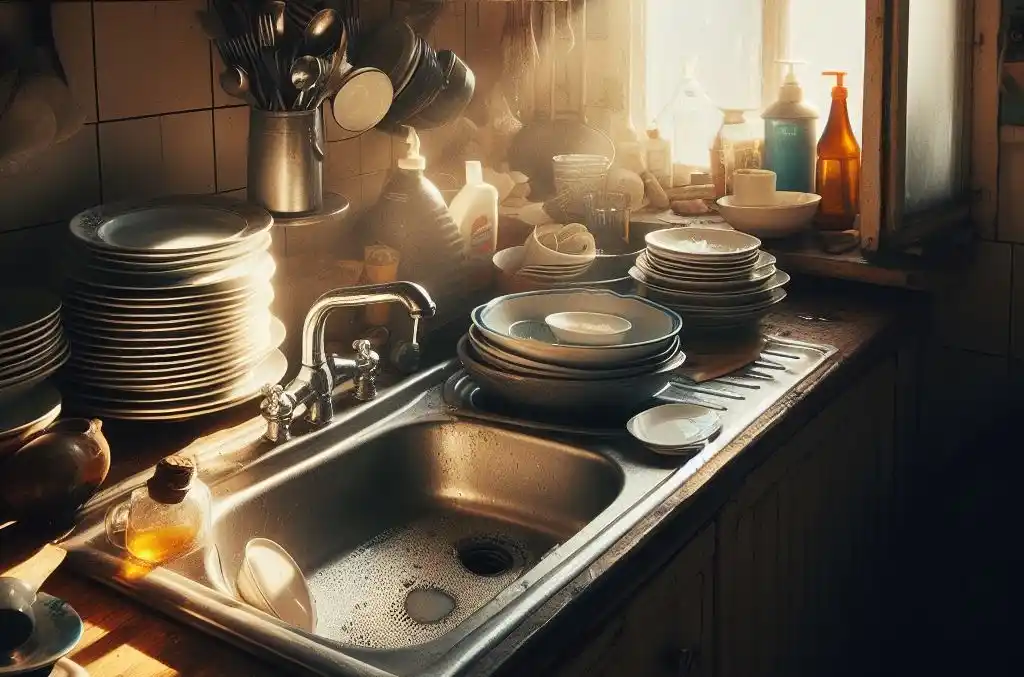11 Steps in Washing Dishes by Hand for Sparkling Clean Cookware
Washing dishes by hand might seem like a simple task, but there are tips and techniques you can use to get your dishes extra clean and hygienic. Read on to learn the 11 steps in washing dishes by hand properly so you can have sparkling clean pots, pans, glassware, and utensils every time.
Table of Contents
Introduction to Washing Dishes by Hand
Washing dishes by hand instead of using a dishwasher has some advantages. Handwashing allows you to inspect each dish and utensil more thoroughly and ensure all food particles, oils, and grime are removed completely. It also uses less water and electricity.
However, without the proper technique, washing dishes by hand can fail to sanitize your cookware properly or leave spots and film behind. Follow this 11-step guide to learn how to hand wash dishes for clean, germ-free results every time.
Why Learn Proper Steps for Washing Dishes?
- Removes all grease, grime, bacteria, and leftover food
- Leaves cookware hygienically clean and safe
- Avoids water spots and filmy residue on glassware
- Makes dishes sparkle without tedious scrubbing or rewashing
- Extends the lifespan of delicate cookware that can’t go in the dishwasher
- Saves water and electricity over using a dishwasher
1. Prepare Your Dishwashing Supplies
Before filling your sink to start washing, make sure you have all the necessary supplies handy:
- Dish soap – Use a concentrated formula designed for cutting grease
- Sponges – Have a scrubbing side and a soft side for delicate cookware
- Dish towels – Absorbent microfiber towels are best
- Drying rack – Let dishes air dry instead of towel drying
- Rubber gloves – Protect skin from hot water and chemicals
- Double sink or dish pans – One for washing, one for rinsing
2. Rinse Dishes of Leftover Food
Rinsing your dishes first serves a few purposes:
- It prevents food bits from spreading and sticking as they interact with water
- It makes washing easier by softening and removing crusty food
- It keeps drains from clogging with food particles
To rinse:
- Hold dishes under running water and use fingers or a soft sponge to lightly scrub away any excess food.
- Pay extra attention to removing clinging food from corners and crevices.
- Shake pans so food bits fall away before soaking.
What Items to Rinse First?

Rinse delicate glassware first, then lightweight dishes and utensils before finally tackling heavy pots and pans coated in baked-on food. This prevents grime from getting spread onto already-cleaned dishes.
3. Fill the Sink Basin for Washing
Fill your sink basin halfway with hot water, then squirt a generous amount of concentrated dish soap into the stream. The hot temperature helps dissolve grease, while dish soap cuts through oil and grime.
Swish the water gently to form suds without creating too many bubbles. Bubbly water makes it hard to see if dishes are getting cleaned properly.
Sink Setup
Use a divided double sink if possible – wash dishes on one side, then dunk them in clean rinse water on the other side. If you only have a single sink, fill it with soapy wash water first, then drain and refill with clean rinse water when the wash cycle is complete.
4. Soak Cookware in Soapy Water
Letting dishes soak in hot, sudsy water gives the soap time to penetrate and loosen stuck-on food.
- Completely submerge dishes and cookware in the soapy water.
- Let them soak for 15-30 minutes if there is heavy grime.
- Delicate glassware only needs a quick dip before washing.
Rotate items around occasionally while soaking so all sides get exposure to the cleaning solution.
5. Wash Each Dish Thoroughly
Washing each dish by hand ensures no food bits or grease escapes your notice. Follow these washing steps:
- Use a soft sponge or dishcloth to gently wipe around the inside and outside of glasses and cups.
- Carefully hand wash delicate glassware to prevent breaking.
- Scrub plates, bowls, and utensils with a soft scrubbing pad, alternating between circular and back-and-forth motions.
- Use a stiff-bristled scrub brush to clean tough grease and burnt food off pots and pans. Target crevices and the bottoms.
- Remove stubborn spots with baking soda or a multipurpose cleaner like Bar Keepers Friend.
- Rinse under hot running water periodically to keep grime from resettling.
- Place washed items in the clear rinse water side of a divided sink or set aside if using a single basin.
6. Frequently Change Out Dish Soap Water
To prevent grease and grime from getting redeposited onto clean dishes, change out the wash water frequently. Replace it when:
- Suds and bubbles disappear.
- The water looks cloudy.
- You finish washing delicate glassware.
- You complete heavily soiled pots and pans.
Drain the dirty, greasy water and wipe food bits out of the sink basin before refilling with clean hot water and a fresh squirt of soap.
7. Rinse Dishes Thoroughly After Washing
The rinse step is crucial for removing all traces of soap along with loosened food and grease. To rinse properly:
- Dunk dishes in clean, hot water to remove soap.
- Rub crevices with your fingertips to dislodge stuck-on suds.
- Rinse delicate crystals under a gentle stream of water rather than immersing them.
- Place rinsed items on a drying rack; don’t towel dry.
Change the rinse water frequently to prevent residue from building up.
8. Let Dishes Air Dry

Instead of towel drying, let dishes sit on a rack until completely air-dried. Air drying has advantages:
- Prevents water spots and streaks.
- Allows rinse water to fully evaporate so no residue remains.
- Eliminates the risk of transmitting bacteria via damp towels.
- Needs no effort compared to vigorous towel drying!
Position dishes so water can drip freely off the edges. Point knife blades down so moisture doesn???t collect in handles.
9. Clean as You Go
As you wash dishes, also remember to:
- Frequently wipe out the sink basin so it stays clean.
- Replace stained or smelly sponges.
- Hang up dish towels and gloves so they dry out between uses.
- Take out the trash when it gets full of food scraps.
- Put away dried dishes and cookware so the counters stay clean and clear.
10. Handle Special Cookware Properly
Certain pans, tools and appliances need special care when hand washing:
- Enameled Cast Iron – Avoid metal utensils and abrasives that damage the finish.
- Nonstick Pans – Use soft sponges and low/medium heat to clean; metal scratches the coating.
- Wooden Spoons + Cutting Boards – Don’t soak; wash gently by hand with mild soap and hot water; air dry.
- Stainless Steel – Rub gently following the grain direction or use Bar Keepers Friend to remove stubborn spots; towel dries promptly.
- Carbon Steel – Avoid harsh dish soap; dry thoroughly after rinsing or seasoning will streak.
11. Spot Check Glassware Before Storing
Before putting away glassware, spot-check items:
- Hold up glasses, cups, etc, and examine them in bright light.
- If you notice cloudiness, streaks or soapy film spots, wash the item again.
- For stubborn water spots or mineral buildup on glassware, use distilled white vinegar or lemon juice to dissolve it, then rinse thoroughly.
With these 11 steps for washing dishes by hand properly, you’ll get cleaner, shinier cookware that’s pleasant to use for cooking and serving. While it takes a bit more elbow grease than loading a dishwasher, the hands-on process allows you to inspect every dish and utensil to remove all lingering food, grease and buildup.
Summary of 11 Steps in Washing Dishes
- Gather supplies – dish soap, sponges, towels, gloves, drying rack, divided sink/pans
- Rinse off excess food
- Fill the sink basin with hot soapy water
- Soak heavily soiled items
- Scrub every dish thoroughly
- Change wash water frequently
- Rinse dishes very well after washing
- Air-dry dishes instead of towel-drying
- Clean as you go – sink, sponges, towels, counters
- Handle special cookware properly – cast iron, nonstick, wood, stainless steel
- Inspect glassware for spots before putting it away
Following this complete dishwashing process consistently results in sparking clean, sanitized dishes with no greasy film or soap spots marring their surface. Plus, it extends the lifespan of your fragile glassware and pricy pans by gently removing stuck-on grime by hand instead of subjecting everything to the intense heat and spray cycles of a dishwasher.
While washing dishes might seem tedious, keeping your cookware properly clean improves safety, hygiene, and enjoyment of home cooking. Implement these handwashing steps and techniques for a gleaming, spotless kitchen everyone can be comfortable using.
FAQs
Do I need to wear gloves when washing dishes?
It’s recommended if you have sensitive skin or open wounds. Gloves can also protect your hands from hot water and harsh chemicals.
What’s the best temperature for washing dishes?
Warm water is ideal for most dishes, as it removes grease effectively without damaging delicate items. Use hot water for very greasy pots and pans, and cool water for fragile items like glasses.
How often should I wash my sponge and brush?
Rinse them thoroughly after each use and wring them out to remove excess water. Wash them with dish soap and hot water once a week, or replace them every two weeks.
Is air drying better than using a towel?
Air-drying is more eco-friendly and prevents dish towels from getting damp and smelly. However, if you’re short on space or need your dishes to dry quickly, you can use a clean, lint-free towel.








